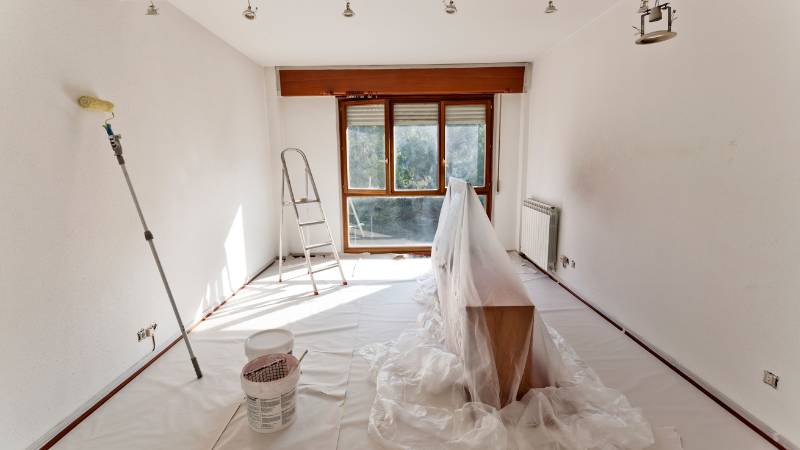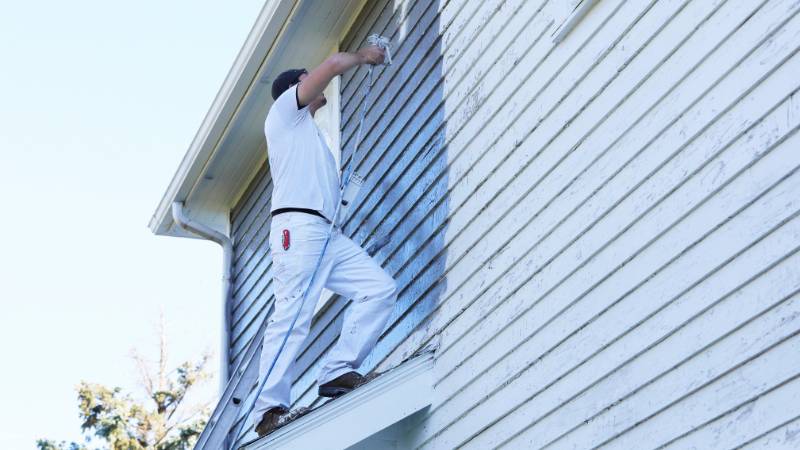How to Prepare for Painting Your Home: A Complete Guide

Having your home painted is a big undertaking. It’s also a fun project and a great way to refresh the space without having to make a huge investment. Professional painting costs range anywhere from $3.00 to $4.50 per square foot, on average although in some regions it can be higher, this is a fractional investment when compared to a full renovation.
Of course, as with any project, there are some preparations involved that you’ll need to take care of before painting can begin. This guide will provide insight on exactly what steps to take before painting your home, from the time you decide to do it until the painters arrive.
Not only does this make the entire process go more smoothly, but it makes it easier for the painters to do their job. It also ensures that none of your property is damaged in the painting process.
So, You’ve Decided to Paint – Now What?
As soon as you decide that you want to paint your home, you’ll need to grab a piece of paper and start taking notes. What room(s) do you want to paint? Are you going to repaint the trim too? What about ceilings? Perhaps you’re planning an exterior paint job. That comes with its own concerns, which we’ll talk about later in this guide.
Your next step should be to reach out to professional painters to discuss your project. You don’t need to have a solid plan yet; you don’t even have to know what colors or rooms you’re considering. As long as you know that you are going to paint, you can start talking to painters.
The beauty of this is that experts can help you plan your project much more quickly and often give your ideas and inspiration that you may not have come up with on your own. Plus, if you start working with them from the start, you’ll be much more connected throughout the process and once the job is finished, you’ll have a team that you can rely on for future needs, as well.
You’re already at the point where you should be in your planning – getting more information. It’s a good idea to learn about home painting and what to expect so that you’re not surprised. Plus, it makes the process less stressful when you’re informed and prepared.
To that end, let’s look at the steps to prepare your home for painting.
Preparation 101: Step-by-Step
Interior Painting Preparations

Clear the Space
Start by removing wall hangings and décor from the space. Wrap up fragile items and pack things away so they are protected until they can be replaced. This is also a good time to start clearing knick-knacks, decorative items, and anything else that could be knocked down, broken, or otherwise in the way of the project.
Right before the painters come, you will need to move all the furniture out of the space. If you’re having the entire home painted, the painters may decide to go room-by-room so that you can clear one or two spaces at a time. Be sure to discuss this with them so that you know how to prepare your space for their arrival.
You might be able to move furniture to other rooms, but some of it might have to go out to the garage or be put in a temporary storage unit. Some painters will even tell you that it’s fine to just move the furniture to the middle of the room. They’ll tarp everything and make sure that they stick to the walls to avoid any paint getting on your belongings.
Finally, get the people and pets out of the space. It is much easier for professional painters to do their jobs in an empty room or home. It prevents potential accidents involving children or pets and removes obstacles for the painters. This means they can work more efficiently, and your pets or kids don’t get covered in paint!
Clean Surfaces
It might sound counterproductive to clean walls that are about to be painted anyway, but that’s not the case. Wiping down walls ensures that dirt and debris don’t get caught in the paint and cause imperfections. This also removes buildup and dirt that could affect the paint finish. Dirt also likes to build up on trim areas like the tops of door frames and on your baseboards. Your painters will thank you if they have a clean surface to paint. Take time to dust, sweep, and wipe things down with a damp cloth before the painters arrive.
Remove Obstructions and Provide Access
If you have other obstructions or access issues besides the furniture in your home, you’ll need to address those so that the painters can work quickly and easily. When your painting contractor comes to do the estimate, they will typically be able to let you know exactly what they’ll need come paint day. This is less of an issue indoors because you’re not blocking off entire rooms, but it’s important to consider.
Speaking of access, you may also want to ask the painters about opening the windows. They may supply their own fans to help move the air around, but the circulation of fresh air will keep the fumes from building up. If it’s too humid, hot or cold, they may advise keeping the windows closed because the humidity and temperature can affect the way paint dries.
Exterior Painting Preparations

As mentioned, exterior paint prep is a bit different than interior paint jobs. Therefore, we wanted to cover it in a dedicated section so that you can plan accordingly and anticipate what to expect. Here are the steps to make sure that your home’s exterior is ready when the painters arrive.
Step One: Remove Items and Obstacles
Some people have furniture and other items outside of their homes that will get in the way of painting. There might be potted plants that need to be moved, a decorative “welcome” sign on the porch that needs to come down, and so on. If anything is blocking or covering the exterior of your home that can be moved, move it. More common items include outside furniture, plants/trees/vines, house numbers, mail boxes, and other outside decorations.
Your painting contractor will be able to do a walk-around with you when they come to give you an estimate. They will also use this time to point out what to do about the various items on the exterior of your home. You can even ask if they’ll handle these steps or if you need to have things out of the way when they arrive.
Step Two: Clean the Exterior
Your home’s exterior gets filthy just from existing in the elements. Before you can start an exterior painting job, you will need to fully clean the exterior. Whether it’s wood, siding, or any other material, a good cleaning can do wonders. Power washing is usually the most effective option, and it’s one that your painters often offer to do for you as part of their process. If they don’t do it themselves, painters can often refer you to a different company who can take care of this for you. If you choose to take care of this part of the process by yourself, the goal is to remove dirt and mildew build up, the goal is not to remove paint. If you attempt to remove paint while washing, you risk damaging the surface.
Step Three: Make Necessary Repairs
This is another task that your painters may handle for you, but it has to be done before painting can begin. Go around the home and look carefully at all of the exterior elements. Look for damage, missing pieces of siding, or anything else that doesn’t look right or appears to need some attention.
If you’re doing this yourself, make sure that you wear a dust mask or respirator, gloves, and eye protection for safety. Use caulk to fill holes, sand down rough surfaces, and scrape off loose or peeling paint. If you’re not handy or just don’t want to do the work, ask your painters to take care of repairs before they begin their work. Most painters are fully capable of completing small repairs that aren’t typically within the scope of painting.
Step Four: Covering and Protecting
Now that the basic prep work is done, when the painters do arrive, they will begin taping off and covering the areas of the home that are not getting painted, such as windows and doors, trim, roof lines, and so forth. This prep process really just depends on the scope of work being completed. They will make sure that everything is properly protected and secured so that there is no paint transfer.
You can assist with this process by getting items out of the way when possible so there’s less to worry about protecting. You might not be able to move windows and doors, but you can take down planter boxes and other things of that sort.
There are some other preparations that you may choose to undertake yourself, but these often will fall within the scope of hiring painters.
Step Five: Sanding and Priming
Once the exterior is clear and repairs are made, there may be several areas that require some sanding. It can be because the surface is rough, or the previous paint’s finish is very glossy and might require some roughing up.
Again, your painters will typically take care of this as part of their process. However, it’s an important step that can’t be skipped if you want the best outcome. After sanding is complete, they will start applying the primer.
Priming is an essential step for most paint jobs because it ensures that the final coat adheres evenly, covers up imperfections better, and make it easier to make bold color changes without having to apply several coats.
After this, your exterior will be ready for painting and you can be confident that it’s been done correctly.
After Painting: Putting It Back Together
Okay, so now you know how to prepare for painting, but what about after the work is done? How long do you have to wait to put things back? Are there certain things you have to do?
Ultimately, you don’t really have any tasks related to the paint job that you need to tend to after it’s done. It’s best to wait a few days, or even up to a week, before starting to hang things on painted surfaces so they don’t stick and damage the paint. Many paints take up to a full month to fully cure, but you don’t have to wait that long.
You can put the furniture back as soon as the walls are dry, but you’ll want to keep them a safe distance away, so they don’t damage the new paint. As for the exterior, you can reinstall any items you took off your home once the paint is dry. Your painters might advise that you wait a few days to put things too close to the exterior. Our suggestion is to wait a few good dry warm days, and you shouldn’t run into any troubles.
Taking the time to do the prep work makes cleanup and restoring your home after painting a breeze. When you choose to work with reputable, experienced professional painters, it becomes even easier. Since you’ll know what to expect, the entire process will be less stressful.
Let the Experts Do Their Work
Typically, when you choose professional painters, they will handle almost all of the prep and cleanup work. The removal of household items, wall hangings, rugs, furniture, etc. will be up to you so that they’re not liable for damages, but some painters may offer assistance with moving large items if you ask nicely!
Beyond that, you’ll want to get out of the way and let the painters get to work. They’ve got years of experience and they know what they’re doing. Be prepared to not use certain spaces while they’re being painted. If you’re painting the exterior, access to your home may be blocked at times. However, this is usually short-lived and minimally disruptive.
If you’re ready to give your home a fresh new look inside or out, reach out to Elite Trade Painting. Our team of experts can help you explore all the options for a new paint job that brightens your home, accentuates your new style preferences, and gives it a fresh, clean look. Plus, we’ll walk you through each step of the process and guarantee a finished result that you love. Contact us today for your estimate!
 (877) 663-5483
(877) 663-5483 (844) 333-1387
(844) 333-1387



